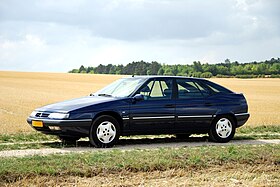Citroën XM
| Citroën XM | |
|---|---|
 |
|
| Overview | |
| Manufacturer | Citroën (PSA Group) |
| Production | 1989–2000 |
| Designer | Bertone |
| Body and chassis | |
| Class | Mid-size luxury / Executive car (E) |
| Body style | 5-door hatchback 5-door station wagon |
| Layout | FF layout |
| Related | Peugeot 605 |
| Powertrain | |
| Engine | 2.0L I4 2.0L I4 16 valve 2.0L I4 Turbocharged 3.0L V6 12 valve 3.0L V6 24 valve 2.9L V6 24 valve 2.1L I4 Diesel 12 valve 2.1L I4 Turbodiesel 12 valve 2.5L I4 Turbodiesel 12 valve |
| Dimensions | |
| Wheelbase | hatchback:2,850 mm (112.2 in) station wagon:2,850 mm (112.2 in) |
| Length | hatchback:4,708 mm (185.4 in) station wagon:4,963 mm (195.4 in) 1998–2000 station wagon: 4,950 mm (194.9 in) |
| Width | hatchback:1,793 mm (70.6 in) station wagon:1,794 mm (70.6 in) |
| Height | 1,392 mm (54.8 in) (most Berline models); some turbo models 1,385 mm (54.5 in); 1,466 mm (57.7 in) (1998 V6 Break) |
| Curb weight | 1,310 kg (2,888 lb)-1,550 kg (3,417 lb) |
| Chronology | |
| Predecessor | Citroën CX |
| Successor |
Citroën C6 Citroën C5 |
The Citroën XM is an executive car that was produced by the French automaker Citroën between 1989 and 2000. Citroën sold 333,775 XMs during the model's 11 years of production. The XM was voted 1990 European Car of the Year.
Launched on 23 May 1989, the XM was the modern iteration of the Big Citroën, a flagship saloon replacement for the Citroën CX. The XM estate was launched two years later, until which time the estate version of the CX remained in production.
The XM inherited a loyal global customer base of executive class customers and a clear brand image, but did not enjoy the commercial success and iconic status of its predecessors, the CX and the DS, which both raised the bar of automotive performance for other manufacturers.
With total sales over its lifetime of just 330,000 units in 11 years, and the fact that its replacement Citroën C6 was not launched until the end of 2005, the XM might be considered a failure. By the second half of the 1990s, sales were in sharp decline.
Despite its common roots with the Peugeot 605, the XM may still emerge as a collectible car, as the DS and CX both did.
There were many advances, most apparently designed to counteract the main criticisms of its predecessor. The CX leaned in corners, so the XM had active electronic management of the suspension; the CX rusted, so the XM had a partially galvanised body shell (most surviving XMs have very little corrosion); the CX was underpowered, so the XM offered the option of a 3.0 L V6 engine – the first V6 in a Citroën since the Maserati-engined SM ceased production in the mid 1970s.
Ventilation was markedly more effective in the XM. Rear accommodation in the XM was improved over the CX in both width, legroom and height. In particular the rear passengers were seated higher than those in the front in order to afford a good view out, important for a vehicle which would operate in French government service. The XM shared a floorpan with the Peugeot 605, and the two models fared similarly in both teething problems and market acceptance. Unlike the 605 sedan design, the XM was a liftback design - a feature thought to be desirable in certain European markets.
...
Wikipedia
